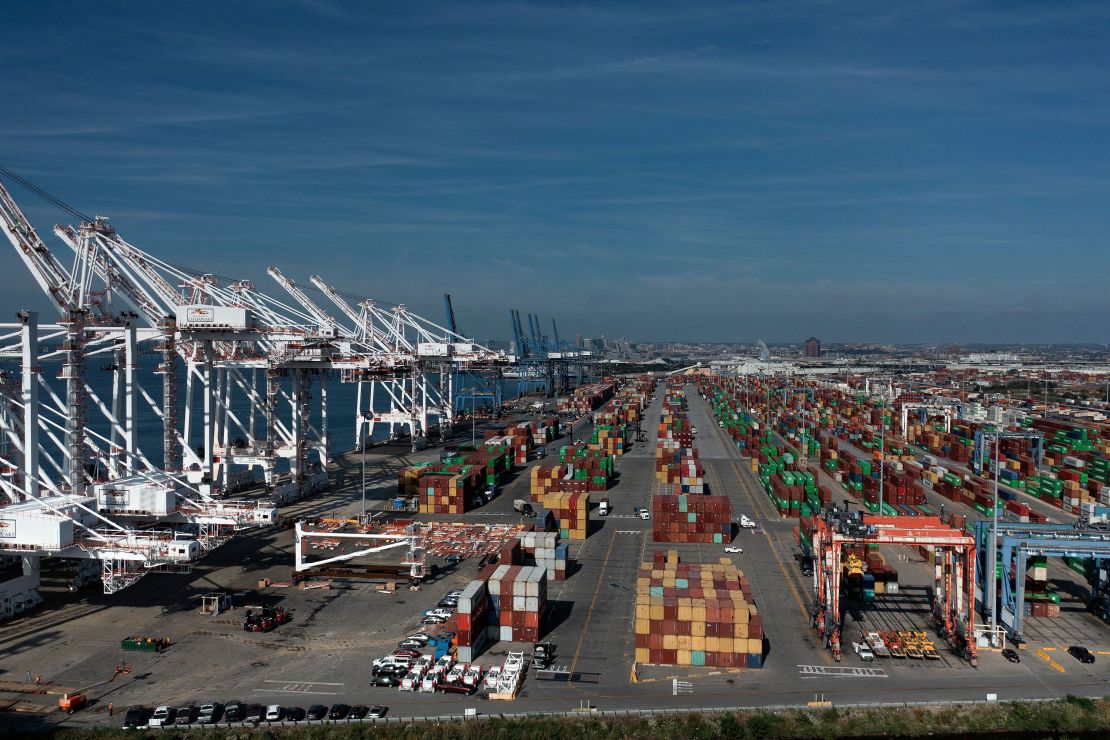Russian President Vladimir Putin is fond of nuclear saber-rattling: On the eve of Russia’s full-scale invasion of Ukraine in February 2022, the Kremlin leader presided over the rehearsal of a nuclear strike, and his not-so-veiled nuclear threats have since kept US officials on edge.
This week, Putin once again rattled the arms-control world by revealing proposed changes to his country’s nuclear doctrine. In a meeting Wednesday of his Security Council, the president said Russia would revise the doctrine to potentially lower the bar for the use of nuclear weapons, adding that Moscow would regard an attack by a non-nuclear state that involved or was supported by a nuclear state as a “joint attack against the Russian Federation.”
Nuclear retaliation, Putin continued, could be considered “once we receive reliable information about a massive launch of air and space attack weapons and their crossing our state border. I mean strategic and tactical aircraft, cruise missiles, UAVs [unmanned aerial vehicles], hypersonic and other aircraft.”
In simple terms, Putin was delivering a warning to Washington and other backers of Ukraine. The revision to the doctrine comes as Ukraine (a non-nuclear weapons state since it gave up claims to nuclear weapons after the collapse of the USSR) presses the United States for long-range weapons that would allow it to strike deeper inside Russia.
The doctrinal revamp is clearly meant to make Western policymakers think twice as Ukrainian President Volodymyr Zelensky presents his “victory plan” to the Biden administration. By brandishing the big stick of Russia’s nuclear arsenal, Putin is implying that the potential costs of providing Ukraine that weaponry may be too high for the West.
Longshore workers at ports from Maine to Texas are set to walk off the job early Tuesday, staging what could become the most disruptive strike to the US economy in decades.
The strike could stop the flow of a wide variety of goods over the docks of almost all the cargo ports on the East Coast and Gulf Coast – everything from bananas to European wine and liquor, along with clothing, toys, household goods and European autos. Also affected could be parts needed to keep US factories operating and American workers in those plants on the job.
On one side of negotiations is the United States Maritime Alliance, which uses the acronym USMX. It represents the major shipping lines, all of which are foreign-owned, as well as terminal operators and port authorities. It is facing a strike threat by the International Longshoremen’s Association, which represents 85,000 members overall.
While the union says there about 50,000 members covered by the contract, the USMX puts the number of jobs at the ports closer to 25,000, with not enough jobs for all the workers in the union to work every day.
But if those union members walk out, as is widely expected, the strike will shut down three dozen locations at 14 port authorities along the East Coast and Gulf Coast.
Depending on duration, a strike could mean shortages of consumer and industrial goods, possibly driving up prices again. And that could hit an economy that is finally recovering from a pandemic-induced inflation spike.
In addition, the halt of supplies of parts needed by US factories could disrupt those plants’ operations and even lead to temporary layoffs.
Imports and exports affected
The ports involved include the Port of New York and New Jersey, the nation’s third-largest port by volume of cargo handled. But it also includes ports with other specialities.
Port Wilmington, in Delaware, describes itself as the the nation’s leading banana port, bringing in a large share of America’s favorite fruit. According to the American Farm Bureau, 1.2 million metric tons of bananas come in through the ports that could go on strike next week, representing over a fifth of the nation’s bananas.
Nearly 90% of imported cherries, 82% of hot peppers and 80% of imported chocolate all come through containers offloaded at those ports, according to the Farm Bureau. It said the situation is just as significant for beverages, with 80% of imported beer, wine, whiskey and scotch and 60% of rum arriving at East and Gulf coast ports. Spirits are the top import at the Port of New York and New Jersey, according to the authority that runs it.
The Port of Baltimore, which was briefly shut by the collapse of the Key Bridge when it was hit by a container ship earlier this year, handles the nation’s largest volume of auto imports. Further down the coast, the Port of Charleston handles outgoing shipments of SUVs made at BMW’s factory in South Carolina, which exports more vehicles overseas than any other US factory.

There hasn’t been an ILA strike against these ports since 1977. That labor peace has helped them capture market share from West Coast ports that have historically had more contentious labor relations.
The union has pledged to continue to handle military cargo even during a strike and said that passenger ships also won’t be affected. Oil tankers and ships carrying liquified natural gas usually go to other facilities that are not affected by the strike. But almost all the other ports along the two coasts could be affected.
The cost of the strike is likely to be limited if it is relatively short, said Patrick Anderson, president of Anderson Economic Group, a Michigan research firm with expertise in estimating the cost of disruptions such as work stoppages. But a prolonged strike of weeks or more could be a severe economic blow.
“We would be in uncharted territory,” he said.
Where the sides stand
The USMX calls the union’s demands unreasonable. Thursday it announced it had filed an unfair labor practice complaint with the National Labor Relations Board, seeking to get the union to return to in-person negotiations, although that filing is more for show than anything else since it is virtually impossible the labor regulator would act before Monday night’s deadline.
“We remain prepared to bargain at any time, but both sides must come to the table if we are going to reach a deal, and there is no indication that the ILA is interested in negotiating at this time,” said a statement earlier this week from the management group.
USMX has offered upwards of 40% in wage increases over the six-year contract, a person with knowledge of negotiations said. The ILA is reportedly asking for raises of $5 an hour, per year, which would be an immediate 12.8% pay hike on the current top pay of $39 an hour. Repeating that $5 an hour increase each year would result in raises totaling 77% during the life of the contract.
The union says it has continued to talk with the USMX, just not in face-to-face negotiations. It said management knows what it is demanding in order to get a deal done, and that any strike will be management’s fault, not the union. It did not comment on the $5 an hour demand, but it says that $5 an hour of increases works out to an average annual pay increase of just under 10%, which they say is reasonable given the level of profits in the shipping industry.
“My ILA members are not going to accept these insulting offers that are a joke considering the work my ILA longshore workers perform, and the billion dollar profits the companies make off the backs of their labor,” said Harold Daggett, the ILA’s international president and chief negotiator, in a statement.
Shipping rates soared during and immediately after the pandemic, as supply chains snarled and demand surged. Industry profits topped $400 billion from 2020–2023, according to analyst John McCown, which is believed to be more than the industry had previously made in total since containerization started in 1957.

In the past the shipping lines were willing to pay to maintain labor peace, said Peter Tirschwell, vice president of global intelligence and analytics at S&P Global Market Intelligence and chairman of the TPM shipping conference.
“They believed that they make money when cargo is coming and going, and they didn’t want to rock the boat,” he said.
But he said the shipping lines appear unwilling to pay what it takes this time. There are concerns about recent US legislation that passed despite the lines’ opposition; what they see as the Federal Maritime Administration, the US industry regulator, becoming much more hostile to the shipping lines; and he threat of tariffs choking off trade should Republican Donald Trump win the election.
“They have come to see the US as a politically unfriendly place,” Tirschwell said. “The attitude of the ocean carriers has changed.”
And the union sees the profits of recent years as an opportunity to win the big wage gains it hasn’t been able to achieve in the past.
Retailers nervous
Stuck on the sidelines and watching with great concern are businesses that depend on the movement of goods.
Some, especially retailers, have rushed to get their goods in ahead of the October 1 deadline, said Jonathan Gold, vice president of supply chain and custom policy for the National Retail Federation. They’re scrambling to make sure their containers of goods are moved out of the ports before Monday night. But there will still be disruptions, no matter the planning, he said.
“A one-day shutdown takes three to five days to recover from,” Gold said.
The NRF is one of more than 200 business groups that sent a letter to the White House this week asking that the Biden administration act to prevent a strike, saying that the country relies on moving both imports and exports through these ports.
“The last thing the supply chain, companies and employees…need is a strike or other disruptions because of an ongoing labor negotiation,” said the letter.
The letter does not explicitly spell out the action sought, but it implies President Joe Biden should exercise powers under what is known as the Taft-Hartley Act to order a quick end to the strike, as President George W. Bush did when he halted an 11-day lockout of union members at West Coast ports in 2002.
Some economists think Biden will decide to take that action, despite strong union opposition to such a move.
“The potential strike at East and Gulf Coast ports is unlikely to trigger any major economic disruption because we strongly suspect that, this close to the election and despite denials ahead of time, President Biden would have little choice but to step in,” said Bradley Saunders, North American economist for Capital Economics, in a note this week.
Political risks, limited benefits
But so far, the Biden administration has indicated it will not take such action.
Invoking Taft-Hartley risks angering union leaders far beyond the ILA, and Biden, who became the first president to appear on a picket line during the United Auto Workers union strike last year, prides himself on being the nation’s most pro-union president.
Intervening to the benefit of foreign owned shipping lines and in the face of opposition from blue-collar American union members would present its own political peril. But doing nothing and having a strike disrupt the US economy and send prices for some goods higher would also pose political risks.
The Biden administration said it is closely monitoring the talks and has encouraged the parties to negotiate in good faith to reach an agreement. But Biden is not weighing tapping the Taft-Hartley Act, a White House official said.
“We’ve never invoked Taft-Hartley to break a strike and are not considering doing so now,” the official said.
The Biden administration is also working to mitigate any potential impacts to the supply chain should a strike occur.
And if Biden does order an end to the strike, it’s by no means clear how smoothly things will operate at the ports. There are numerous way the workers can slow the flow of freight by strictly following rules in the contract. In a video to members, the ILA’s Daggett said if members were forced back to work they would likely only move a small fraction of their normal cargo volumes.
The shipping lines realize the problem with having Biden order the union back to work, said Tirschwell.
“A senior ocean carrier guy told me yesterday, ‘If they are forced back to work, they can make life miserable for everybody,’” he said.
CNN’s Arlette Saenz contributed to this report.


